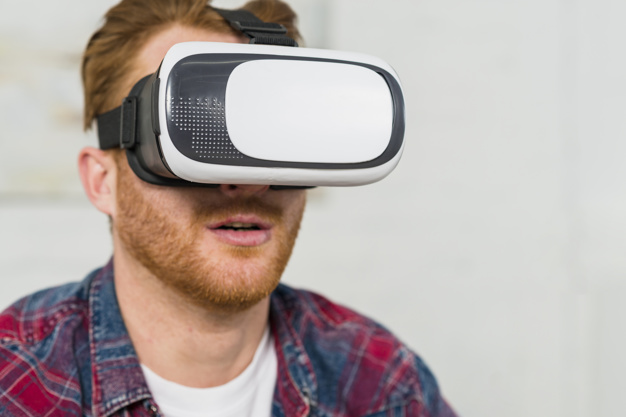Virtual reality is a computer-generated 3D environment that surrounds the user. The environment reacts to the individual actions of the user, creating an interaction in real time. So-called Head-Mounted-Displays (HMD), also called VR glasses, are usually used for this purpose. There are two high-resolution displays (one for each eye) to show the artificially generated images, which together create the 3D effect. The combination of different sensory impressions such as images and sound creates a feeling of new reality and realism. A world that does not really exist is simulated in front of the user’s eyes and enables a full experience. This effect is also called immersion. Immersed in the new environment, the user loses space and time in the real world. VR is already being used in different areas, such as gaming, cinema, education and medicine. Nowadays it is also used for therapeutic treatment.
VR is used for therapeutic purposes mainly in the so-called exposure therapy. In this type of therapy, the patient is placed in a situation that causes anxiety. A differentiation is made between the confrontation with this fear in reality (in vivo) and in imagination (in sensu). The use of virtual reality glasses offers a compromise of these methods. While the mind thinks one would expose oneself to the fear in imagination (in sensu), the fear center in the brain reacts in the same way as if one would confront the fear in reality (in vivo). The advantage is that both patients and therapists would rather engage in a confrontation in virtual reality than face their fear in real life.
Procedure
The anxiety treatment of patients through Virtual Reality Exposure Therapy (VRET) serves as a supplement to conversation-based cognitive-behavioural therapy. At the beginning of the therapy, an anamnesis is taken. The patient’s medical history is recorded. Patients are also given background information on how their fear works. This step is called psychoeducation. Then a fear hierarchy is created together with the therapist. Situations that the patient avoids, the patient has to assess using the Subjective Units of Discomfort (SUDS) on a scale from 0 to 100. Here, 0 stands for no fear at all and 100 for great fear. Before VR treatment, patients also learn various psychological techniques such as breathing exercises, Progressive Muscle Relaxation (PMR), thought regulation, cognitive restructuring and Emotional Freedom Techniques (EFT). Then the actual treatment using Virtual Reality begins. The therapist remains in the same room with the patient. He can accompany the patient through a screen that shows a section of the VR experience or the field of vision of the patient. The starting position in virtual reality is adjusted according to the patient. The adjustment depends on the nature of the phobia, the stage of the therapy and the fear hierarchy.
The patient learns to reduce his fear himself by means of relaxation techniques and exercises. The therapist is at the patient’s side and motivates and calms the patient during the VR experience. In some cases, hypnosis is also used to consolidate what has been learned.
Through the therapy, affected persons should experience that the triggered fears only increase for a short time. The anxiety falls after longer or repeated staying in the situation. In addition, patients are more likely to engage in VR therapy because they know that it is not real.
Examples of treatment
There are many fears that can be treated by VR therapy, for example the fear of animals. Be it a spider phobia, the fear of dog attacks, sharks or wasps. The level of this therapy is individually selectable between one and ten. With these fears the simulation is carried out visually as well as audibly, for example the buzzing of a wasp is perceived by the patient. The patient is not allowed to look around or respond to the soundscape during this treatment.
Another frequently treated fear in this procedure is the fear of heights or acrophobia. Here, patients can decide for themselves how close they want to get to the abyss or walk over real planks on the floor, which lead over a virtual hole. This therapy also uses different levels of treatment for fear of heights, e.g. the patient first walks in a lift, then to a window and finally to a virtual roof terrace.
The fear of public speaking and being stared at (social phobia, ophthalmophobia) is also treated by VR. During this treatment, the patient has to hold a speech in front of a virtual audience, sing karaoke or start a conversation with a stranger in a virtual train. The reaction of the audience varies from attentive to bored and gossipy. The patient thus builds up more self-confidence.
Meanwhile there are many fears that are cured by the VRET therapy. Among them: Fear of highways and driving, claustrophobia, fear of tunnels, fear of elevators, fear of the dark, fear of looking up, fear of men, fear of steps, fear of depth, fear of doctors and shots and fear of exams.
However, VR therapy is not only used for anxiety therapy, but also for addiction therapy, chronic pain, obsessive-compulsive disorders and post-traumatic stress disorders, as well as for the therapy of eating disorders.
In general, this method of treatment is is still far from being at the end of its possibilities in therapy.
Text by Greta Kuch, Lisa Kopp, Sandra Kutscher, Oliver Pfander

